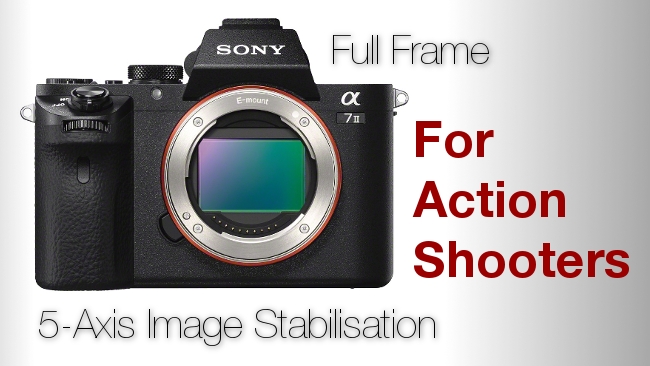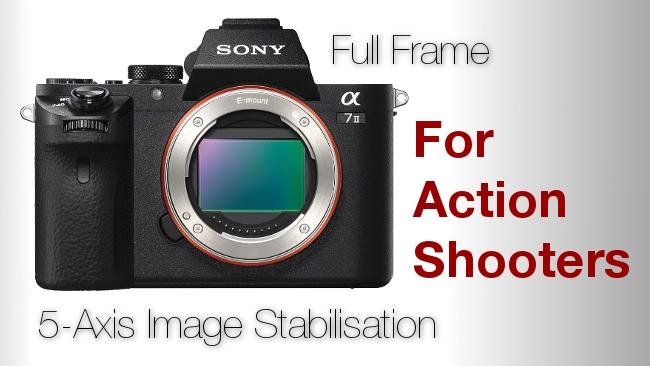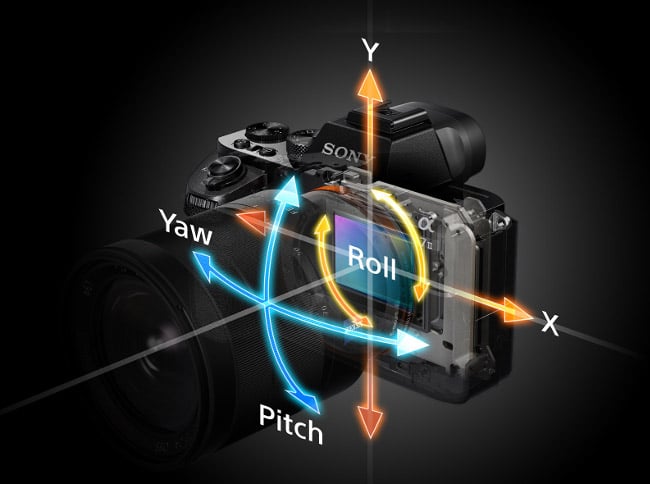
 Sony a7 II
Sony a7 II
Action, extreme sports and low-light video shooters have reason to rejoice, as Sony releases a full-frame camera with optical 5-axis image stablisation
While many videographers have purchased the Sony A7s, the stellar low-light performer with a big dynamic range, and are likely waiting for their Atomos Shoguns to arrive so that they can finally test that cam as a 4K imager, not everyone is ready to jump on the 4K bandwagon just yet. For those shooters who still prefer HD acquisition, and especially run-and-gunners and extreme sports enthusiasts, you're in luck; Sony has released the A7 II, which may answer some of your prayers.
Steady as she goes
The Sony A7 II is a full frame camera (24.3 megapixel sensor) that shoots HD AVC video at 60fps. It can also record to Sony's XAVC-S. There is an S-log 2 mode for a wider dynamic range and a more filmic look.
But the big takeway is the inclusion of an optical 5-axis image stabilisation system built right into the camera. This in-body system performs its stabilisation by moving its full-frame sensor to compensate for angular shake, shift shake, and rotational shake (or roll).

Any lens will do
The benefit of the in-camera stabilisation system will be best when paired with an OSS (Optical SteadyShot) lens, Sony's proprietary in-lens stablisation system, but users should experience some benefit no matter what lens they fit on the new a7 II. This means that it's like having all your lenses outfitted with some level of stabilisation. As someone who has spent a fair bit of time running-and-gunning, I can tell you that some form of optical image stabilisation is almost a pre-requisite for getting good footage, and if this camera performs well in this regard, then it literally multiplies the action shooter's lens choices.
Other bells and whistles
Rounding out the a7 II, the camera sports the BIONZ X image processor (which should produce cleaner, less noisy footage than previous generations), faster, more responsive autofocus, 40% quicker start-up time, and Wi-Fi connectivity. No word on price yet, but the original a7 was originally listed at $1698 and is being offered at deep discounts, so the $1700-price level is a fair guess.
According to Sony, the a7 II will ship in January, 2015.
Check out the Sony a7 II intro video below. For a look at its image stabilisation capabilities, check out another video from Sony on Page Two. For a complete re-print of the full press release, go to Page Three.
Sony's a7 II image stabilisation video
Check out the full press release for the Sony a7 II on Page Three!
Full Press Release
Sony Introduces the α7 II, the World's First Full-Frame Camera with Optical 5-Axis Image Stabilization
Sony has released the α7 II (ILCE-7M2), the next in the α7 series of interchangeable-lens models and the world’s first[i] camera with optical 5-axis image stabilization designed for a full-frame image sensor.
The camera offers outstanding image quality in a compact size and light build, and it carries on the traditions of the α7 series, which includes the world’s smallest and lightest interchangeable-lens full-frame camera (α7R). A 24.3 effective megapixel 35 mm full-frame Exmor CMOS sensor moves along five axes to compensate for camera shake, providing optical image stabilization equivalent to up to 4.5 steps faster shutter speed of correction[ii] for still images. Shooting sharp handheld stills and video is now possible under conditions that may have required a tripod in the past. In this and other scenarios, users can enjoy beautifully rendered images from the full-frame sensor with the convenience of image stabilization. In-camera image stabilization also offers sharper images for those using A-mount lenses on an optional lens adapter.
World’s first full-frame camera with optical 5-axis image stabilization
Detects and corrects various camera shake along five axes for still images and video, including angular shake (pitch and yaw) that tends to occur when shooting with a telephoto lens, shift shake (along the X and Y axes) that becomes noticeable as photographing magnification increases, and rotational shake (roll) that often affects shots at night or when recording video.
The full-frame image sensor moves to compensate for these kinds of camera shake. For still images, stabilization is equivalent to up to 4.5 steps faster shutter speed of correction.
Optical 5-axis image stabilization ideal for a variety of αTM lenses[iii]
Handheld low-light shooting at slower shutter speeds becomes possible, allowing for greater creativity and mobility without the need for a tripod. The camera’s in-body image stabilization is therefore effective even in combination with E-mount lenses without Optical SteadyShot (OSS). For A-mount lenses as well (using an optional mount adapter such as LA-EA4 or LA-EA3), camera shake is compensated for along five axes within the camera body. Users can thus make the most of the beautiful rendering power of various α lenses with the α7 II.
Verify image stabilization results with live view functionality
Monitor the corrected image in real-time on the camera’s LCD screen or in the OLED viewfinder, thus allowing for fine-tuned framing and focusing even when using a telephoto or macro lens.
Speedy, accurate autofocus with Fast Hybrid AF
Wide AF coverage with the employment of a 117-point focal plane phase-detection AF sensor (in combination with a 25-point contrast detection AF points)
117-point focal plane phase-detection AF sensor and 25 contrast detection AF points are placed over a wide area of the screen, making use of the superb tracking capabilities of the phase detection AF and therefore enabling clear capture of moving subjects that might otherwise evade focus.
30% faster AF responsiveness[iv]
A more advanced algorithm is used to detect the subject position, enabling optimal lens drive. In a variety of scenarios, autofocus is very responsive – 30% faster than in previous models.
1.5 times the tracking ability of previous models4 with an improved motion-prediction algorithm
An improved, original Sony algorithm for the prediction of moving bodies results in a 1.5 times improvement in performance in tracking a subject and predicting its next movement. Additionally, AF and automatic exposure (AE) continue to track the subject during high-speed continuous shooting (up to 5 fps), so that a sudden movement or expression of the subject is never missed. Finally, greatly improved tracking ability and subject capture are made possible through the advances in image analysis technology with “lock-on AF,” a feature that optimizes focusing on the subject in accordance with its size.
Superior image quality and enriched video recording functionalities with the full-frame sensor and BIONZ XTM image processing engine
35 mm full-frame Exmor CMOS sensor for high resolution and sensitivity, with minimal noise
The camera is equipped with a full-frame Exmor CMOS image sensor with approximately 24.3 effective megapixels. High resolution and larger pixels enhance sensitivity and reduce image noise to release the full potential of lens’ optical performance. Images are rendered beautifully and bokeh effects attainable only with full-frame sensors become possible.
BIONZ X image processing engine for superb detail and natural textures, less noise
Loaded with an advanced BIONZ X image processing engine. The fast processing enabled by this engine enhances images in several ways, through “detail reproduction technology,” which recreates natural-looking textures even in the minute details of an image; “diffraction-reducing technology,” which prevents loss of detail when aperture stopped down; and “area-specific noise reduction,” which greatly reduces noise while maintaining exceptional detail and texture even under low light conditions such as night time and indoors.
Supports high bit rate XAVC-S recording
In addition to recording in AVCHD Ver. 2.0 Full HD (1920×1080) 60p (50p)/60i (50i)/24p, the camera records in XAVC-S, a consumer format derived from the professional XAVC format.[v] This offers outstanding Full HD video quality at a high bit rate of 50 Mbps. Long GOP compression is used, targeting differences between frames, along with the MPEG-4 AVC/H.264 codec for video. Regarding audio recording, linear PCM is used and files are saved in the MP4 format.
Full-featured video recording that suits professional workflows
Picture profiles enable convenient in-camera tone adjustment. The α7 II also supports the S-Log2[vi] gamma function, which preserves a wide dynamic range, and a wide S-Gamut mode. Other features include Time Code/User Bit (useful in editing), Rec Control (for synced recording with compatible external recorders), marker display/settings, and dual video recording.
Enhanced usability and reliability
Refined usability
Grip shape and height keep the camera steady even when using a large telephoto lens. The shutter button has been shifted toward the front, to a position that feels more natural. This, along with the button’s increased size, helps reduce camera shake. Shooting comfort and convenience were a priority in design. Ten customizable buttons can be assigned to any of 56 functions.
The tilting display features a White MagicTM LCD screen for exceptional visibility even under bright sunlight.
Sharp, high-contrast XGA OLED Tru-Finder™ viewfinder for accurate previewing
An XGA OLED Tru-Finder viewfinder with a 2.36 million dot equivalent resolution and high contrast, enabling faithful reproduction of setting adjustments, fine-tuned focusing using magnified display or peaking features, and bokeh effects. The viewfinder also allows for clear review of previous shots. Because the camera is fully APS-C-compatible, it displays the entire view even when APS-C lenses are used.
Reliability that professionals can appreciate
Sturdy magnesium alloy construction of the top, front cover, and internal structures ensures that the camera is both durable and light. The robust mounting structure easily handles large telephoto lenses, heavy video lenses, and many others.
Main buttons and dials are also sealed to help keep out moisture and dust, and an interlocking double layered construction of media and port covers as well as body seams ensures greater moisture and dust resistance. Overall, the camera is designed to be used by photographers in any number of situations without having to worry about the safety of their cameras.
Quick startup time – 40% fasteriv
After the camera is switched on, it is ready to shoot 40% sooner than current models.
Wi-Fi and NFC enabled for connectivity with mobile devices; support for PlayMemories Camera Apps that allow the camera to evolve even further
- Wi-Fi and NFC connectivity for mobile linking
- Features can be expanded with PlayMemories Camera Apps
By installing an updated Lens Compensation app (enabling the storage of lens information in Exif data, compensation of recorded video, and import/export of lens compensation values), users can manually set correction values for lens peripheral shading, chromatic aberration, and distortion.
To learn more, visit the PlayMemories Camera Apps website: (www.playmemoriescameraapps.com/portal/).
Accessories
VG-C2EM Vertical Grip for the α7 II
A vertical battery grip designed especially for the α7 II, this grip enhances stability and camera control in vertical or horizontal shooting. Holds two NP-FW50 rechargeable battery packs (not included) for longer battery life when shooting. Highly reliable water and dust resistant construction.
Compatible models: α7 II
LCS-ELCB Soft Carrying Case for the α7 II
A case made for the α7 II that includes a leather body case and lens jacket. The battery pack and memory card can be removed without having to take the camera out of the case. NFC/USB are also accessible while the camera is in the case.
Compatible models: α7 II
FDA-EP15 Eye-piece Cup
Soft replacement eye-piece cup designed for comfort.
Compatible models: α7 II, α7S, α7R, α7
α interchangeable lens [A-mount]
70-300mm F4.5-5.6 G SSM II (SAL70300G2)
Telephoto zoom lens that brings subjects into sharp focus while creating the beautiful bokeh that G lenses are known for. Ideal for outdoor sports and wildlife photography as well as short-range shots from as close as 1.2 m. Also suited for portrait and tele-macro shooting such as floral photography.
- Nano AR coating minimizes flare and ghosting from reflections within the lens to improve rendering performance.
- Approximately 4x faster AF tracking than the current lens model SAL70300G.
- Moisture and dust resistant design.
The α7 II will be generally available in Europe from January 2015.
α7 II (ILCE-7M2)- technical specifications
| Lens mount |
E-mount |
|
| Image sensor |
35mm full frame (35.8 x 23.9mm), Exmor CMOS sensor |
|
| Number of pixels (effective) |
Approx. 24.3 megapixels |
|
| Recording format |
Still |
JPEG (DCF Ver. 2.0, Exif Ver. 2.3, MPF baseline compliant), RAW (Sony ARW 2.3 format) |
| Movies |
XAVC S / AVCHD format Ver. 2.0 compliant / MP4 |
|
| Movie functions |
Picture Profile |
Picture Profile (Off/1-7, Black Level, Gamma (Movie, Still, Cine1-4, ITU709, ITU709 [800%], S-Log2), Black Gamma, Knee, Color Mode, Saturation, Color Phase, Color Depth, Detail, Copy, Reset) |
| Other |
Time Code/User Bit, Rec Control, Auto Slow Shutter, Dual Video Rec, Marker Setting |
|
| Clean HDMI output |
1920 x 1080 (60p (50p) / 60i (50i) / 24p) |
|
| YCbCr 4:2:2 8bit/RGB 8bit |
||
| Media |
Memory Stick PRO Duo, Memory Stick PRO-HG Duo, Memory Stick XC-HG Duo, SD memory card, SDHC memory card (UHS-I compliant), SDXC memory card (UHS-I compliant) |
|
| Focus system |
Type |
Fast Hybrid AF (phase-detection AF/contrast-detection AF) |
| Focus point |
Full frame: 117 points (phase-detection AF) / APS-C: 99 points (phase-detection AF) /25 points (contrast-detection AF) |
|
| Sensitivity range |
EV -1 to EV 20 (at ISO 100 equivalent with F2.0 lens attached)
|
|
| Exposure control |
Metering type |
1200 zone-evaluative metering |
| ISO sensitivity (Recommended Exposure Index) |
Still images: ISO 100-25600 (ISO 50/64/80 expandable), AUTO (ISO 100-6400, selectable lower limit and upper limit), Multi Frame NR (expandable up to ISO 51200) Movies: ISO 200-25600 equivalent, AUTO (ISO 200-6400) |
|
| Shutter |
Shutter speed |
Still images: 1//8000 to 30 sec., Bulb Movies: 1/8000 to 1/4 sec. |
| Electronic front curtain shutter |
Yes (On / Off) |
|
| SteadyShot INSIDE (image stabilization) |
Image Sensor-Shift mechanism with 5-axis compensation (Compensation depends on lens specifications) |
|
| 4.5 steps (Based on CIPA standard. Pitch/yaw shake only. With Sonnar T* FE 55mm F1.8 ZA lens mounted. Long exposure NR off.) |
||
| Drive |
Continuous shooting speed*1 |
Hi: Max. approx. 5fps, Low: Max. approx. 2.5fps |
| No. of recordable frames (approx.) during continuous shooting*1 |
Continuous shooting Hi: 77 frames/25 frames (RAW) |
|
| Viewfinder |
Type |
Electronic viewfinder (XGA OLED Tru-Finder) |
| Total number of dots |
2,359,296 dots |
|
| Field coverage |
100% |
|
| Magnification |
Approx. 0.71x (with 50mm lens at infinity, -1m-1diopter) |
|
| LCD screen |
Type |
7.5cm (3.0 type) TFT drive |
| Total number of dots |
1,228,800 dots |
|
| Adjustable angle |
Up approx. 107 degrees, down approx. 41 degrees |
|
| Audio |
Microphone |
Built-in stereo microphone |
| Speaker |
Built-in, monaural |
|
| Interface |
Multi interface shoe, HDMI micro connector (Type-D), Microphone terminal (3.5mm Stereo minijack), Headphone terminal (3.5mm Stereo minijack), Multi / Micro USB Terminal |
|
| Wireless LAN (built-in) |
Wi-Fi Compatible, IEEE802.11b/g/n (2.4GHz band) |
|
| NFC |
NFC Forum Type 3 Tag compatible |
|
| PlayMemories Camera Apps |
Yes |
|
| Battery |
Rechargeable battery pack NP-FW50 |
|
| Weight |
Approx. 599g (with battery and Memory Stick PRO Duo), approx. 566g (body only) |
|
| Dimensions (W x H x D, CIPA compliant) |
Approx. 126.9 x 95.7 x 59.7mm |
|
| Operating temperature |
0-40°C |
|
Tags: Production


Comments